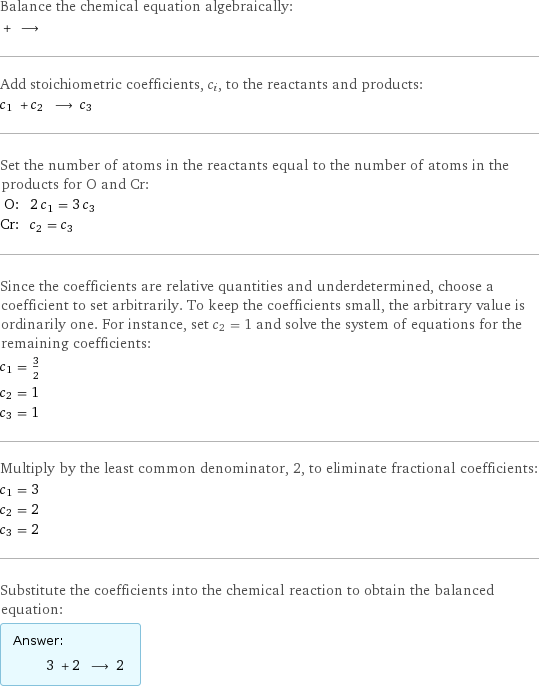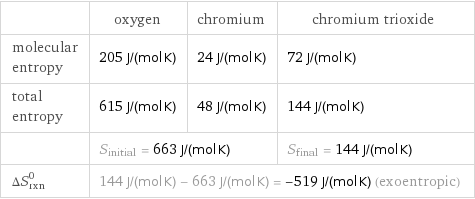Input interpretation

oxygen + chromium ⟶ chromium trioxide
Balanced equation

Balance the chemical equation algebraically: + ⟶ Add stoichiometric coefficients, c_i, to the reactants and products: c_1 + c_2 ⟶ c_3 Set the number of atoms in the reactants equal to the number of atoms in the products for O and Cr: O: | 2 c_1 = 3 c_3 Cr: | c_2 = c_3 Since the coefficients are relative quantities and underdetermined, choose a coefficient to set arbitrarily. To keep the coefficients small, the arbitrary value is ordinarily one. For instance, set c_2 = 1 and solve the system of equations for the remaining coefficients: c_1 = 3/2 c_2 = 1 c_3 = 1 Multiply by the least common denominator, 2, to eliminate fractional coefficients: c_1 = 3 c_2 = 2 c_3 = 2 Substitute the coefficients into the chemical reaction to obtain the balanced equation: Answer: | | 3 + 2 ⟶ 2
Structures

+ ⟶
Names

oxygen + chromium ⟶ chromium trioxide
Reaction thermodynamics
Entropy

| oxygen | chromium | chromium trioxide molecular entropy | 205 J/(mol K) | 24 J/(mol K) | 72 J/(mol K) total entropy | 615 J/(mol K) | 48 J/(mol K) | 144 J/(mol K) | S_initial = 663 J/(mol K) | | S_final = 144 J/(mol K) ΔS_rxn^0 | 144 J/(mol K) - 663 J/(mol K) = -519 J/(mol K) (exoentropic) | |
Chemical names and formulas

| oxygen | chromium | chromium trioxide Hill formula | O_2 | Cr | CrO_3 name | oxygen | chromium | chromium trioxide IUPAC name | molecular oxygen | chromium | trioxochromium
Substance properties

| oxygen | chromium | chromium trioxide molar mass | 31.998 g/mol | 51.9961 g/mol | 99.993 g/mol phase | gas (at STP) | solid (at STP) | solid (at STP) melting point | -218 °C | 1857 °C | 196 °C boiling point | -183 °C | 2672 °C | density | 0.001429 g/cm^3 (at 0 °C) | 7.14 g/cm^3 | solubility in water | | insoluble | very soluble surface tension | 0.01347 N/m | | dynamic viscosity | 2.055×10^-5 Pa s (at 25 °C) | | odor | odorless | odorless | odorless
Units
